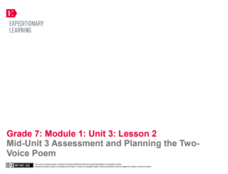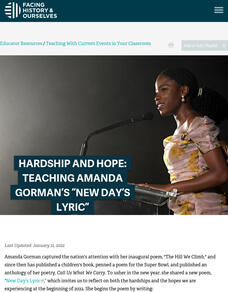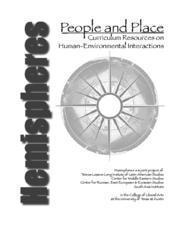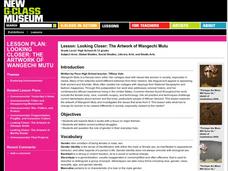EngageNY
Using Routines for Discussing A Long Walk to Water and Introducing Juxtaposition (Chapters 9 and 10)
Take a stand. Scholars consider what it means to take a stand in A Long Walk to Water. They complete an activity by taking a stand and moving to a labeled section of the room that matches their opinion. Readers then examine text features...
EngageNY
Analyzing Point of View in A Long Walk to Water
Readers analyze how characters are juxtaposed in Linda Sue Park's novel A Long Walk to Water and discuss their ideas with the class. Then, with a partner, they complete a juxtaposition practice worksheet.
Curated OER
Cartoons for the Classrooms: Wall Street Financial Meltdown
Combine two current events (2008) in one political cartoon. This handout examines the Large Hadron Collider, a scientific invention that caused a sudden fear of black holes, and the financial meltdown on Wall Street. Background...
EngageNY
Mid-Unit 3 Assessment and Planning the TwoVoice Poem
Class members prepare to write a two-voice poem that compares and contrasts two characters from Linda Sue Park's novel, A Long Walk to Water. Pupils also complete the mid-unit assessment, answering questions about juxtaposition from the...
Curated OER
Knowledge or Instinct? Jack London's "To Build a Fire"
Learners examine the relationship of man and nature in "To Build a Fire" and discuss the juxtaposition of knowledge and instinct. They investigate third person, omniscient point of view.
Curated OER
Editorial Cartoon: Censorship
Students explore the concept of juxtaposition. In this editorial cartoon lesson, students analyze an editorial cartoon techniques to develop an understanding of juxtaposition and symbolism used in the cartoons.
Curated OER
Knowledge or Instinct? Jack London's "To Build a Fire"
Students closely read " To Build a Fire," to explore the use of narrative point of view and debate the distinction between knowledge and instinct. The elements of literary naturalism and how they relate to Jack London's work is examined...
Curated OER
"Killing Chickens" by Meredith Hall
After reading the essay "Killing Chickens" by Meredith Hall, provide your class with these thoughtful questions. After answering the four questions listed, your writers attempt to write their own descriptive essay. Challenge them to...
Curated OER
A Tale of Two Cities Quiz
A Tale of Two Cities begins with one of literature's most memorable paragraphs; see if you can complete it, sentence by sentence, in this quiz! Most questions are fill-in-the-blank, but the juxtaposition makes this easier.
EngageNY
Analyzing Text Structure: “Water Is Life” Paragraphs
Water, water everywhere. Readers revisit paragraphs six through nine in the article "Water is Life" to answer text-dependent questions. They then pair up to reread the article focusing on its structure and record their thoughts on...
Curated OER
Digital Dada
Students explore the concept of photomontage the juxtaposition of photo images and fragments of images to create new images and meanings. To research Hannah Hoch and the Dadists who created them. To incorporate digital technology in the...
Facing History and Ourselves
Hardship and Hope: Teaching Amanda Gorman's "New Day's Lyric"
Class members come together to study Amanda Gorman's poem "New Day's Lyric." After a close reading of the poem, learners watch a video of Gorman reading her poem, and then craft additional lines for the poem where they offer suggestions...
Texas Education Agency (TEA)
Annotate and Analyze a Paired Passage: Practice 1 (English II Reading)
What do a colt and a boy in a tree have in common? More than might be first apparent. The fourth interactive in a series of ten introduces readers to intertextuality, the process of using abstract thinking to consider how one text...
National Constitution Center
Born in the U.S.A: Music as Political Protest
Though often used in shows of patriotism, Bruce Springsteen's 1985 song "Born in the U.S.A." is critical of America's role in the Vietnam war and its treatment of American veterans. High schoolers analyze the song's lyrics in an activity...
PBS
Discuss 22-year-old Amanda Gorman’s inaugural poem “The Hill We Climb”
Two poems by National Youth Poet Laureate Amanda Gorman are spotlighted in a PBS lesson. Young scholars conduct a close reading and watch videos of Gorman reading her inaugural poem "The Hill We Climb" and "The Miracle of Morning." They...
Curated OER
THE GOOD AND THE BADDE: ARE STEREOTYPES A PERFECT FIT?
Students examine stereotypes of women from The Good and the Badde in juxtaposition with the female characters in The Taming of the Shrew. Through this exercise, students locate evidence from the text of the play to support or refute...
Curated OER
For Public Display
Students compare three works of art to understand how juxtaposition can express a point of view. They brainstorm topics of interest to them and their respective communities that could act as a springboard for curating individual exhibits...
Curated OER
In A Station Of The Metro And A Pact
Students are exposed to two different works of poetry in order to complete a task of comparing and contrasting them. They analyze the poem and identify the juxtaposition. The analysis is compiled by them to make a class report of it.
Curated OER
Juliius Caesar
Young scholars discuss suggestive language and the use of symbols and foreshadowing in Shakespeare's plays. In this Julius Caesar lesson, students discuss the idea that men control their own fates. Young scholars examine the words of...
Curated OER
Can You Believe Your Eyes?
Students investigate hidden messages by analyzing images. For this art analysis lesson, students assess specific photographs by their use of light, framing, distortion and size. Students create their own juxtapositions in images and...
Curated OER
Hemispheres: People and Place
Here is an astounding series of lessons, designed for high schoolers, on environmental policy. By studying water conservation in rural India, the role of the government, and the reaction of the people, learners begin to formulate...
Curated OER
Lesson: Looking Closer: The Artwork of Wangechi Mutu
Social issues of gender and media stereotypes, begins with a multi-sensory experience. Learners view the painting Backlash Blues and make critical comments based on what they see. They then read the Langston Hughes poem and listen to the...
Curated OER
Lesson: Unmonumental: Yesterday's News
Upper graders are tasked with developing a social consciousness as they analyze the impact of the news media. They view a presentation depicting various media events in order to understand threshold moments in history. There are three...
Curated OER
Back to School: Style Analysis
Jump back into expository writing and analysis at the start of a new school year! Start with a review of an authors' stylistic choices in diction, syntax, treatment of subject matter, and figurative language. Writers choose a text to...
Other popular searches
- Juxtaposition Great Gatsby
- Juxtaposition in Art
- English Juxtaposition
- Poems With Juxtaposition
- Juxtaposition in Poetry
- Juxtaposition "Advertising
- Juxtaposition Advertising
- Juxtaposition in Literature
- What Is Juxtaposition
- Juxtaposition Worksheets
- Juxtaposition "Advertising"
- Ethan Frome Juxtaposition

























